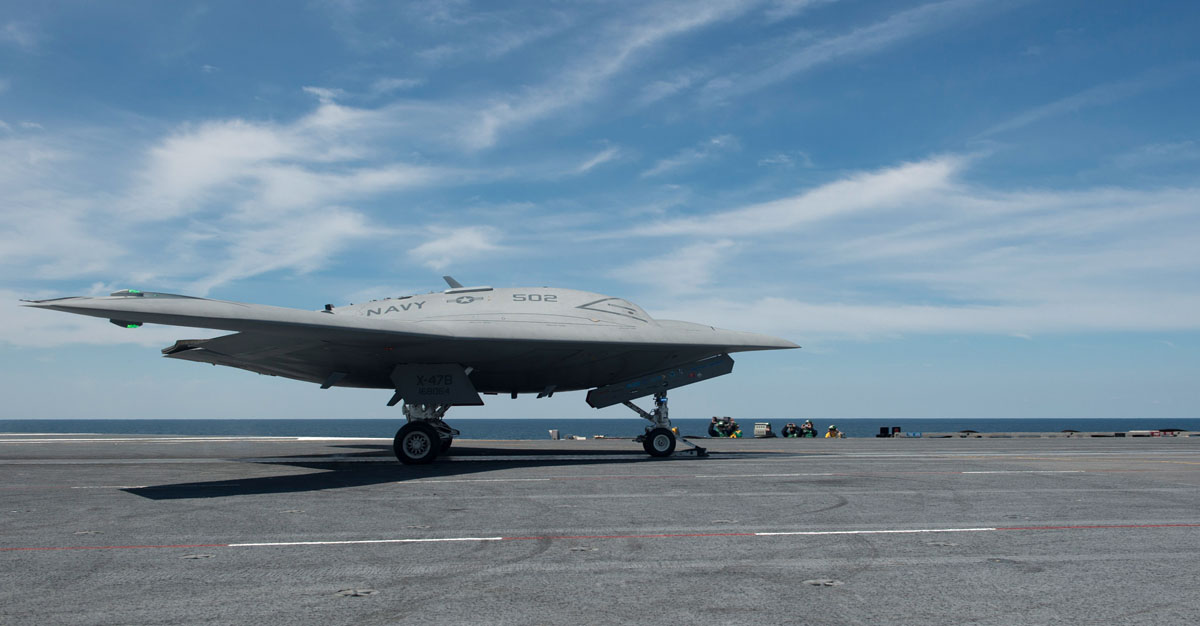
The bat-winged X-47B stealth drone roared off the USS George HW Bush near the coast of Virginia and flew a series of pre-programmed maneuvers around the ship before veering away toward a Naval air station in Maryland where it was scheduled to land.
"This is really a red-letter day. May 14 we all saw history happen" said Rear Admiral Ted Branch, the Atlantic naval air commander. "It's a marker ... between naval aviation as we've known it and the future of naval aviation with the launch of the X-47B."
Because of its stealth potential and a range nearly twice that of the F-35 Joint Strike Fighter, the X-47B and its successors are seen as a potential answer to the threat posed by medium-range anti-ship missiles developed by China and Iran, defense analysts said.
The missiles and other so-called anti-access, area-denial weapons would force U.S. aircraft carriers to operate far enough from shore that piloted aircraft would have to undergo refueling to carry out their missions, leaving them vulnerable to attack.
But with a range of 2,000 nautical miles, an unmanned jet like the X-47B could give the Navy both a long-range strike and reconnaissance capability.
"That makes it strategically very important," said Anthony Cordesman, a senior defense analyst at the Center for Strategic and International Studies. He described the drone as "essentially a really long-range stealth system."
The X-47B - one of only two demonstrator models made by Northrop Grumman - carries the equivalent of two precision-guided bombs. It was catapulted from the aircraft carrier on Tuesday using the same sling-shot system that sends manned aircraft aloft.
Landing on board
It is scheduled to undergo two weeks of testing aboard the carrier leading up to a landing on the ship, in which a plane's tailhook grabs a wire that will slow it and keep it from plunging overboard.
While the carrier takeoff represented a significant milestone, defense analysts are focused on the next step, when the Navy attempts to use what has been learned with the X-47B to develop an unmanned aircraft for actual operations.
"The X-47B is a great story," said Mark Gunzinger, a defense analyst at the Center for Strategic and Budgetary Assessments think-tank. "It's a milestone and a step forward for unmanned, carrier-based aviation. But I think the real story is what's next. How do we operationalise this capability?"
Future variants of the drone could probably be designed for full-spectrum broadband stealth, which means it would be hard for radar to locate it, analysts said. That level of stealth would be one of the drone's major defenses.
US drones currently in use in places like Afghanistan and the tribal areas of Pakistan - like the Predator and Reaper -are not up against any air defenses and are not stealthy aircraft.
Because of its long range and the Navy's need to have it take off and land, day and night, from an aircraft carrier, the X-47B has been designed to operate with far greater autonomy than the remotely piloted aircraft currently in use.
That has raised concerns among some organizations worried about the heavy US reliance on drones in warfare and the rising use of autonomous robots by the American military.
Human Rights Watch, in a report launching its recent campaign against "killer robots," cited the X-47B as one of several weapons that represent a transition toward development of fully autonomous arms that require little human intervention.
A follow-on program - known as the Unmanned Carrier Launched Airborne Surveillance and Strike System, or UCLASS - is expected to build on what was learned with the X-47B to produce operational aircraft.
"As anti-access environments proliferate, the Navy's Carrier Air Wings will require a mix of aircraft, both manned and unmanned, with the extended range, persistence, stealth, and payload to ensure US power projection around the globe," said Representative Randy Forbes, a Virginia Republican and member of the House of Representatives Armed Services Committee.
COMMENTS (15)
Comments are moderated and generally will be posted if they are on-topic and not abusive.
For more information, please see our Comments FAQ


1722491856-0/yusef-dikec-012534223-16x9_0-(2)1722491856-0-270x192.webp)















@Raj - USA: yes you did send the rover to mars but hey it was a German technology that got it there !
@anonymous: Actually this inventive genius things seem to spring from the mixing of the genes of Celtic Britains, Angles and saxons from German
@anonymous: Hmm Lets see America! a list of innovations and technology NOT invented or discovered by Yanks Radio, Radar, Television, the steam engine, the internal combustion engine, the diesel engine the jet turbine engine Jet powered aircraft need I go on , OK the helicopter, the rocket motor, artillery, I see you want more the electronic watch, the electronic computer, the electronic calculator , the integrated circuit the Laser DVD machines the Tape recorder The Telegraph the Telephone the patent was bought from canadians by Bell, OOp's your inventions and innovations are looking prety sick lets go further the Telescope, the sextant for navigation, Actually it would be a much simpler and smaller list if I were to name those things invented or discovered by Yanks!
@ Blake...Agree ,,I commented yesterday that Raj diverting from the topic. not published yet.
@Raj - USA: Dear Raj, What we have in the above article is a bunch of low functioning US navy people bragging jubilantly because they have developed yet another killing machine. However, now that you have brought up the topic of medicine and health I suppose I could be as facetious and irrevelent as you, and point out that there are 250 reported daily deaths in the US alone, which are induced by the medical fraternity. Perhaps the world will be better off being subjected to American X-47B drones rather than the US medical system.
@Bill: @anonymous: @John Marsh: @vasan: @Sexton Blake:
Reminds me of what my Afghan friend once told me jokingly. He said that Afghanistan is one of the richest countries because they do not have any IMF / World Bank loans, any foreign debt and no local debts either.
USA is the only country that has sent Mars Rover that has landed on Mars and has been operating there for 6 years. They did it decades ago and no country has been successful to land their vehicle on mars. Yet we see comments here boasting of Iran's technological advances when Iran cannot manufacture even simple pharmaceutical drugs . Iran imports most of the pharmaceutical drugs and all raw material used in the manufacture tiny pharmaceutical industry is imported. How many countries like Iran or other Gulf countries or African countries can survive for if USA and the West simply stop exporting pharmaceutical drugs or the raw materials to manufacture these drugs?
US drones and valor stories are propagated only from one side media,and these military information are transfer to media only by CIA or its agencies. Can any one tell me about the second mean of these news? Can anyone tell why these drones can't be operated on high mountainous regions? These drones are only killing people like you and me on land populations. The real fighters run away to mountain peaks. Suppose , they are killing fighters of Afghanistan, (according to ISAF resource the Taliban fighters numbers were 6000-20000), seeing this statistics they should had finished all the Afghanistan fighters by now. Secondly, nobody knows how many dead bodies of their soldiers NATO & US receiving, because the other side has no media.. Anybody knows that lot of bodies of US soldiers come on american bases in every spring and summer season despite of their latest technology. Why ?
Mr. John Marsh,
I have had an opportunity to travel and spend time in many countries. The UnitedStates has its problems, but by far the best I have experienced when compared to rest of the world for encouraging innovation. It is still all relative.
As for using ESA or Russian launchers is a matter of economics like outsourcing call-center and IT jobs to Asia. This certainly doesn't reflect as a lack in capability.
You indeed pointed out a few problems, and if you choose to look for problems, you would fine many in any country. However, choose to see the other side as well, and just to take an example -- Apple, Google, Facebook,Twitter,Microsoft --- where else do you find so many successful and innovative companies.
There is got to be something that UnitedStates does differently. Accept it and give it the credit where it is due.
@vasan: You have been misled and misinformed! Germany demanded all it 3,500 tons of gold back from the FED the FED said wait ten years why is that? It's because they no longer have the Gold! No Country has gone broke when it is endowed by innovation and ideas. So how come the US is rated 37th in the world of academia ? The latest super tech weapons are not fit for purpose i.e. the Lemons and garbage cans called the F22 and F35 ! how come the US has to rely on E.S.A. and Russian launchers to get back into earth orbit? How come with all this technical superiority there was a complete failure to prevent the Sandy Hook shooting the Boston Marathon Bombings The mothers day parade shootings? Face it the US infrastructure is decrepit roads rail and air travel because of a lack of money. 100 million Americans living in absolute poverty, tent cities, cars and broken down trailers! All operated by a corrupt state and National/federal government, with a third rate media all run from Tel-Aviv! Tell me again how great America is???
@Raj - USA: Well Well what a pointless article! Iran has already rendered this drone technology useless! The US navy surface ships might as well have large targets painted on their gunwale's! the Yakhont and hoot missiles can take these things out before your tech can react! The Littoral warships according to the Pentagon cannot survive a determined attack they are too lightly armored are not as stealthy as advertised their electronic systems are too easily hacked and the offensive armament is inadequate! Your Air-force has been saddled with the flying lemon called the F22 and the flying garbage can the F35. These projects have now been limited or cancelled because the US is broke, Bankrupt of idea's and money! The US army is not doing too well in Afghanistan where a couple of hundred Taliban are keeping them terrified and locked into a loosing war and that includes all the coalition of the willing! The Stock market is riding high on all the fiat money printing and US dollars being returned back into the US economy, hyper inflation and collapse looms for these bits of printed paper loaned at interest by the privately owned corporation scam artists called the Federal reserve! For me you yank dummies can believe what you like that belief will not change the reality one bit!
They are really afraid of anti-ship missiles for on fast attack crafts. Big ship days are over.
@vasan: Dear vasan, My apologies if I have it wrong. However, I can only go on US treasury figures, which you obviously have not perused. The following figures may interest you and if I am incorrect I will wait for your reply with bated breath:
US total debt: 59 trillion dollars. US total payable interest per annum: 3 trillion dollars. US trade deficit: 708 billion dollars. US unfunded liabilities: 123 trillion dollars. People living in poverty: 50 million. Food stamp recipients: 48 million. US gold reserves: 537 Billion. These figures, at the very least, give an indication of skimming the edges of bankruptcy to me.
Sexton Blake. This is the best joke I ever heard. US bankrupt?? They got the highest gold reserve and their debts can be easily serviced. Even if one assumes it is bereft of money, it is full of ideas and innovations. No country has ever gone bankrupt when it is endowed with such brilliant innovative population and an environment which promotes them. Countries which get intoxicated with idealogies and religion are bankrupt even if financially well off because it stumps their biggest asset, ie humans
@Raj - USA: Dear Raj, The US is bankrupt. The Americans spend money on deadly weapons that they cannot afford. This latest weapon just means that many more thousands of innocent children will be killed.
Petty minds discuss people, mediocre minds discuss events and great minds discuss ideas. Some countries never tire themselves from discussing and planning on how to deny land space to US troops. They discuss only of historic events. They thought that if the land space is denied in their lands to US troops they can defeat the mighty USA. USA no longer needs any land space in any other countries for its military. Nor does it need any supply routes to keep its troops abroad. In the next 3 - 5 years you shall see USA deploying deadly robotic soldiers that can analyze and act independently. Still some foolish Gul's will keep chanting "America has lost the war and is retreating, wagging its tail". USA no longer needs a "tikana" and its "nishana" is precise and pulverizing. Geographical restrictions are no longer of any significance to US for fighting its wars anywhere in the world. Just 2 - 3 years ago, many countries were claiming that US cannot afford any war as it is already bankrupt.